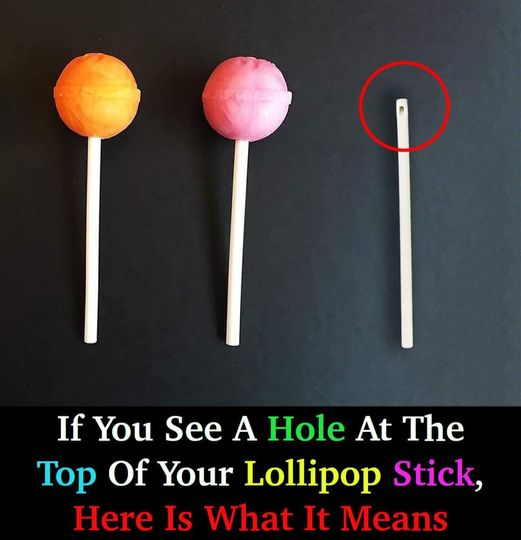If You See a Hole at the Top of a Lollipop Stick, this is What it Means

he history of lollipops, particularly in the US, is a little skewed. Archeologists believe some version of the sweet treat may have been created hundreds of years ago. However, it was only within the last hundred years that a feature was added, making the stick hollow. However, many wonder why this may be. It turns out there are two main reasons.
Advertisement
Brief History of Lollipops
Sugar was once a rare commodity. Therefore, people had to be creative in order to enjoy sweet treats like lollipops or gummies. It is believed that before the 17th century, places like Egypt and China made varying nut and fruit concoctions. They then added honey for preservation and a touch of sweetness. Next, sticks were added to make them easier to eat. These examples are some of the earliest recorded variations of today’s confection.
After the 17th century, sugar became more readily available. Thus, countries like Britain began boiling sugar and adding sticks to make lollipops. Although there is some speculation regarding lollipops in the US, George Smith claimed to “invent modern style” lollipops in the early 1800s. The man from New Haven, Connecticut, thought that adding sticks to candy would make it easier to eat. Interestingly, at the time candy was soft or chewy, rather than hard candy.
Another hundred years would pass before lollipops, and their production would see another reboot. In 1908 Racine Confectionary Machine Co. introduced an automated lollipop production machine. The machine allowed for around 4,200 lollipops with sticks to be made per hour. However, a few years later, Samuel Born invented a similar machine known as the “Born Sucker Machine.” He was awarded the keys to the city of San Fransisco for his “innovation.” It differed from previous models because it inserted sticks into the candy rather than on the end of a stick.
Creating Lollipops with Hollow Sticks
Variations of lollipops have been around for centuries. Some were made with fruits and nuts, others pure sugar, and eventually, most also had added and artificial flavors. Sometimes, lollipops even added dyes to make the candy more aesthetically pleasing for children. Over the last few decades, one thing has changed about the packaging for lollipops. Some lollipops, like Tootsie Pop and Dum Dums, had solid paper sticks. While better for the environment than their plastic counterparts, the paper sticks, to some extent, actually inhibited consumers’ ability to enjoy the product.
In contrast, manufacturers of Chupa Chups have been making lollipops since 1958. Originally producing only seven flavors, today, the international company now sells more than 100 flavors to more than 150 countries worldwide. They knew something that other candy makers were yet to find out. Their lollipops have been made using hollow sticks with holes at the top, serving two purposes.
Reason 1: Functionality
The first reason lollipops are now made with hollow sticks is that the little square at the top allows candy makers to “anchor” the candy down.
Reason 2: Safety
Because lollipops are made with those convenient sticks, they paint a picture that they’re intended for consumption on the go. While they do make things easier, they’re also considered a choking hazard. Children may accidentally swallow them while running, although it’s never advised to let a child do anything but sit while consuming food, drinks, snacks, or candy. However, just because it’s not advisable doesn’t mean it doesn’t happen. As a result, numerous children suffered from death or injury as a result of either careless eating or over-excitement.
On the other hand, the hollow sticks prevent airflow from being obstructed in case of accidental swallowing. For example, in 2020, a 4-year-old boy from Texas was taken to the hospital after accidentally swallowing a lollipop stick. Although the plastic hollow stick had to be removed through surgery, his airways remained open enough that he didn’t choke to death before getting help.
Small Downside to Hollow Sticks
In addition to environmental impacts, another downside to plastic hollow sticks is that they, too, can cause injury. For children or adults with sensitive gums or teeth, the plastic ends can cause minor cuts along the gums and roof of the mouth. Arguably, a small price to pay, when the cost could be a life instead.
Lollipops aren’t Alone
Unsurprisingly, lollipops aren’t the only consumer product with this feature. Pen caps were once considered a severe choking hazard. Subsequently, manufacturers used a concept similar to candy makers. Ultimately, making a hollow pen cap with a hole at the end.
Lollipops and other sweet treats have changed significantly over the course of human history. People are adaptable and always on the hunt for the next big thing. Therefore, it’s not unlikely that we’ll continue to see candy and other foods evolve over time to address health or safety concerns. With that in mind, it’s interesting to see innovation and creativity come to life from generation to generation.